Geese Over Water
Expand your goose-hunting opportunities with these special-specific decoy strategies for lakes, flooded fields, marshes, and ponds
Expand your goose-hunting opportunities with these special-specific decoy strategies for lakes, flooded fields, marshes, and ponds
llustrations by Frederick Stivers
From tiny cacklers and ocean-loving brant to suburban honkers and prolific snows and specklebellies, North America is home to a remarkable abundance and variety of geese. Despite their many differences, all goose species have one thing in common-they rely on water for resting and roosting habitat. Geese are waterfowl, after all, and while they are often pursued on dry fields, they can also be hunted very effectively where it's wet.
Granted, this style of goose hunting has its share of challenges that field hunters largely avoid, like balky outboard motors and tangled decoy lines. But when everything comes together, there is nothing quite like the spectacle of a large flock of geese tolling to a water spread. Veteran goose hunters know that a solid decoy strategy is key to a successful water hunt. Here, four experts share their go-to spreads for Canadas, specks, brant, and snows.
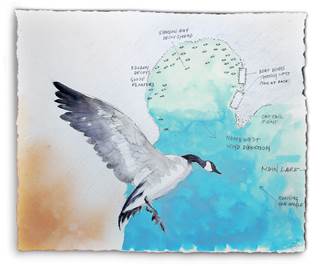
Hunting Canada geese over water is an especially attractive tactic for those who are pressed for time or don't have a trailer full of decoys, says veteran Minnesota waterfowler Ben Cade. "Compared to field hunting, I do very little scouting before hunting geese over water," he says. "The area I hunt traditionally has a good number of locally raised birds, and it also receives quite a bit of traffic when the migration is on. That combination makes it possible for me to hook up the boat on a Friday afternoon, do a bit of scouting that evening to see where birds are concentrated or roosting, and then formulate a plan for the morning."
Cade's first priority is finding a way to get his boat into the hunting area without disturbing roosted birds. His second consideration is selecting a cattail point or other location where his decoys will be highly visible to trading flocks. He also checks to ensure that there is sufficient natural cover to conceal his large boat blind.
"I typically set up with the wind crossing in front of me and the sun at my back. This keeps the birds' attention on the decoys instead of the boat, and the sun creates shadows that help keep us concealed, which is especially important when geese pass overhead," Cade says.
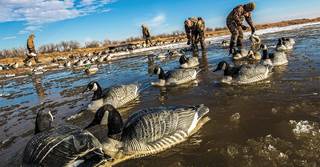
Photo © dougsteinke.com
His spread typically consists of three to four dozen floaters, although he may bump the number up when he's hunting larger bodies of water or if he is targeting especially large concentrations of birds. He places his decoys in a loose J configuration consisting of pairs and family groups of three to four decoys each. He also leaves a large landing zone directly in front of his boat blind to give approaching flocks plenty of room to finish.
When geese are at a distance, Cade uses a flag to draw attention to the decoys but usually puts the flag down when birds are working, again to keep their attention off the boat. "I use a similar approach when I'm calling," he explains. "I try to make as much noise as possible to get their attention, but then back off as they begin to work the decoys."
A Final Tip: Cade recommends bringing along a smaller and more maneuverable tender boat, which is also equipped with a boat blind and used to hide hunters. He uses this smaller craft to retrieve downed birds and to make trips back to shore to pick up supplies or to drop off and pick up hunters throughout the day.
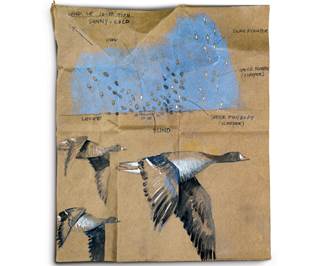
Northern California's Sacramento Valley is home to some of the best waterfowling in North America, and this includes outstanding hunting opportunities for white-fronted geese, or specklebellies, which winter in large numbers in the region. Decoying white-fronted geese over flooded rice fields is one of Ryley Haugh's favorite ways to hunt the birds. Haugh, who works as a guide at Merlo Waterfowl Company near Chico, says specklebellies tend to respond well to decoys and calling, allowing hunters to run traffic on birds moving between roosts and feeding areas.
"Also, rice fields that are just getting water put on them after harvest are choice locations. They love to be the first birds there to feed on the leftover rice," Haugh says.
Whether hunting geese in transit or over new water, Haugh says, "concealment is a priority, especially when you're trying to convince birds to change their plans for the morning. Invest the time to make sure your blind is grassed up really well before the hunt, and then touch up the cover throughout the day, especially around any doors or openings that see a lot of wear and tear from hunters and dogs."
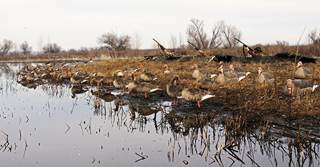
Photo © Blake Fisher, RNTCalls.com
Running traffic can require aggressive calling, Haugh says, and he uses sharp, loud yodels to get the attention of specklebellies at a distance. Once the birds are headed in his direction, however, he backs off the call and watches the geese for any reaction.
"They will tell me what they want to hear, and sometimes that means I stay pretty quiet," Haugh says. "I rarely get aggressive again with yodels or clucks unless the birds start to leave."
Haugh deploys his decoys to replicate a flock of "relaxed birds." He places a mix of four dozen floaters and full-body decoys in sleeper or resting poses in a simple U pattern in front of the blind. In addition, he will add a handful of snow goose and swan decoys on the upwind side of the spread to help center decoying birds in front of the blind, and even more important, to increase the visibility of his decoys.
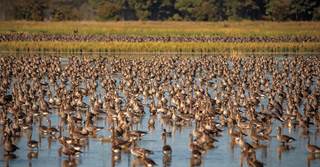
Photo © Cason Short, ByersFarm.com
"Visibility is really important when I'm hunting those birds in transition, to help get their attention if I'm slightly off the line between the roost and the feed," Haugh says. "And I think the swans seem to work a bit as confidence decoys, too, and give the appearance that this rice field is a safe place to grab a drink of water and relax for the afternoon."
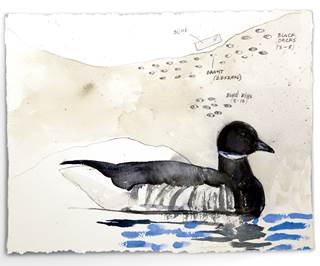
Mike Bard has hunted Atlantic brant off the coast of Long Island, New York, for more than 20 years. The setting, which has the Manhattan skyline as a backdrop, is one of the reasons Bard keeps coming back.
"It is such a different experience compared to hunting in a cornfield or another body of water," says Bard, who is owner and guide at Game Hogg Hunt Club in northern New York. "The winding channels of the salt marsh, the short grass, the tide, and the birds themselves make it so unique."
The tide plays a central role in brant hunting, Bard says, as an outgoing tide triggers the movement of geese into the marsh to feed on exposed vegetation on the mud flats. Before a hunt, he scouts to find concentrations of brant loafing, either on the water or along the shoreline, and then studies the tide map to find nearby areas where the geese will likely feed.
Depending on water levels, Bard looks for channels between loafing and feeding areas and then sets his decoys off a point where the water narrows. "Brant really do not like to fly over land, so they will follow these channels throughout the marsh. Setting up in one of these choke points along a channel forces those birds to work closer to the decoys," Bard explains. "The great thing about brant is that they are some of the most social birds I've ever hunted. If a flock of 50 works down a channel, I expect to see six or eight birds peel off and look at the decoys."
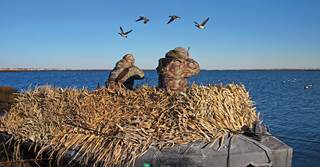
Photo © GaryKramer.net
Bard's decoy spreads tend to be on the small side, largely out of necessity due to the size of his boat. He also needs to move his decoys frequently to adjust to changing water levels. His typical spread consists of only two dozen floaters, a handful of silhouettes to help break up the outline of his blind, and a few duck decoys to attract any black ducks, buffleheads, or greater scaup in the area.
"For concealment I've moved away a bit from using the layout-style blinds and now use a panel-style blind covered in marsh grass," Bard says. "The geese do not seem to mind the blind sitting tall above the grass."
Bard also calls and uses a flag sparingly. "Location is really the most important thing in hunting brant," he says. "If you do your homework, understand the tides, and know where the geese are loafing and feeding, you're pretty well set. Brant love to decoy."
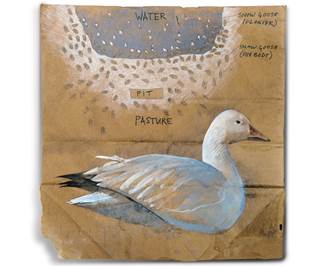
The spring Light Goose Conservation Order is known for awe-inspiring tornadoes of snow and Ross's geese spiraling into massive spreads of decoys, and South Dakota hunter and guide Ben Fujan says those opportunities aren't limited to hunting in dry fields. "Water spreads can be absolutely lights out for snows, especially when there's not a lot of runoff or sheet water in the fields or when ice is just coming off the lakes," he says. "If you can create some open water using an ice eater or other method, it's a very effective way to hunt spring snows, even if you're dealing mainly with adult birds on the front edge of the migration."
As crazy as the hunting can get, there is a method to how Fujan selects locations for his water setups, which typically consist of a farm pond or tailwater pit in a pasture or harvested corn or soybean field. A top priority is to select a location within a historical migration corridor to maximize the amount of goose traffic overhead. Fujan is also mindful of any major resting areas. "I do not want to set up near an established roost or refuge or anywhere close to real birds on the water. I simply cannot compete," he says.
While open water is the draw for migrating birds, Fujan uses a relatively small number of floaters. Instead, he places a massive spread of full-bodies-typically around 1,500 decoys-from the water's edge up into the pasture or field in a teardrop shape. He positions his blind 40 to 50 yards away from the water on the upwind side of the landing zone.
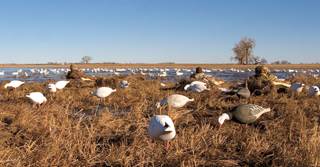
Photo © Scott Fink
"For years we tried to hunt right on the pond, and the birds consistently tried to work behind the blind, so we decided to push everything back," Fujan says. "It's been a good change, and it makes life a lot easier when you can drop birds on dry ground rather than out in the water."
Since the spread imitates loafing rather than feeding birds, the action typically doesn't start until a few hours after sunrise, giving hunters a chance to enjoy the spectacle of the spring migration as mallards, pintails, and other ducks often work the spread before the geese start flying. "Our water spreads are typically the last ones we pick up each spring. People love to hunt over them, and they seem to be effective throughout the migration," Fujan says.
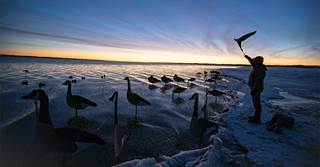
Photo © dougsteinke.com
Ducks Unlimited uses cookies to enhance your browsing experience, optimize site functionality, analyze traffic, and deliver personalized advertising through third parties. By continuing to use this site, you agree to our use of cookies. View Privacy Policy